| |||||||
 |
| Search this Thread |  237,585 views |
| | #1 |
| Team-BHP Support  Join Date: Feb 2004 Location: Bombay
Posts: 24,023
Thanked: 34,033 Times
| Mitsubishi Lancer EVO X : Test Drive & Review The Mitsubishi Lancer Evolution X has been launched in India at a price of Rupees 49.95 Lakh (ex-showroom, all India) What you'll like about the EVO: • Aggressive styling, yet doesn’t yell for attention • 291 BHP makes it one really quick sedan • Dual-clutch SST auto gearbox does a brilliant job • Packed with AWD, electronics & mechanicals. Makes even an average driver feel invincible • 4-doors and seating for 5. Take your full family along for the fun What you won't: • 50 Lakh Rupee CBU price-tag, for a Lancer • Much more civilized and mainstream than previous generation EVOs • No steering feedback, not a very interactive driving experience • No manual transmission option. Also, we get the FQ-300 366 N-m spec • A measly 6 month / 10,000 km warranty NOTE: Click any picture to open a larger higher-resolution version in a new window. 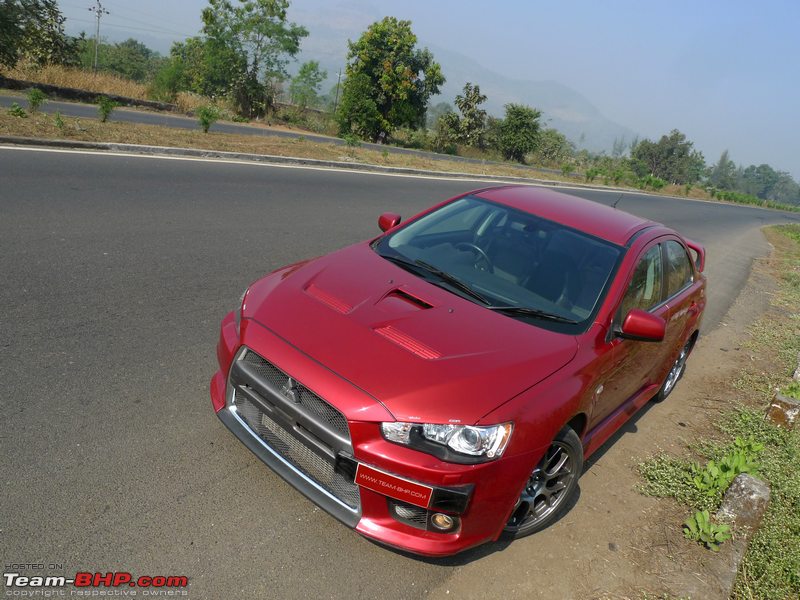 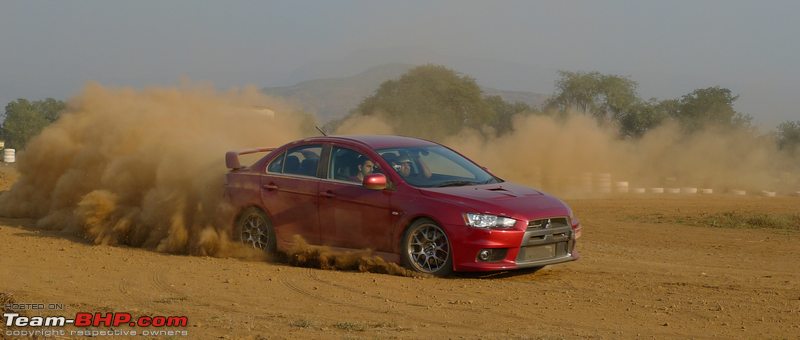 Here's a video showing the EVO on the road, and on the dirt too. Must watch! Last edited by Rehaan : 11th September 2011 at 18:23. |
| |  (10)
Thanks (10)
Thanks
 |
| The following 10 BHPians Thank Rehaan for this useful post: | ashishk29, Flyer, gaurav_chopra04, khanak, msbehave, Nazaar25, petrolhead_neel, Researcher, Varun_HexaGuy, vredesbyrd |
| |
| | #2 |
| Team-BHP Support  Join Date: Feb 2004 Location: Bombay
Posts: 24,023
Thanked: 34,033 Times
| Exterior  Mitsubishi has been talking about bringing in the EVO X for a few years now, and enthusiasts have been listening intently. The halo effect of the EVO is something that Mitsubishi is leveraging. The launch has been so long awaited that they’ve actually got the coverage and press stretched out over a few years. 25 lakhs - wow. 30 lakhs - I want one! 35 - not bad. 3 years later, 49.95 lakhs, and it's here. Ex-showroom of course. I’m not sure how many enthusiasts are still listening. The EVO X is a fairly large car, inside and out. Noticeably larger than the Lancers we’re used to seeing on Indian roads. It has a 30mm wider track compared to the EVO IX, and a 25mm longer wheelbase. No surprise that its also 114 kgs heavier than its predecessor. Its kerb weight (+fuel) tips the scales at a fairly substantial 1605 kgs, mostly due to the center differential and other components of the AWD system. With a 140 mm ground clearance, we had no issues of scraping on speed-breakers. I think the average speed-breaker height in the metros has gone down significantly in the last 5 years! The front overhang is fairly significant and in combination with the front lip is something you need to watch out for only when getting in and out of a steep driveway (or onto a car-wash ramp). I faced some difficulties with the latter – though doing the same ramp in reverse was not an issue. The EVO gets just the right amount of attention on the streets. Only the enthusiasts drool and stare. Others just give it a passing glance, dismissing it for your average kitted up sedan. If it wasn’t for the deep burble of the exhaust and the glowing red, they probably wouldn’t notice it at all. That’s the beauty of the EVO. A wolf in sheep’s clothing. On the down-side though, you’ll have unknowing Accord drivers thinking that they have a fair chance at out-gunning you during an overtaking move on the highway. Add to that, expect your mother or wife to ask you if you just brought home a new Civic! Whatever. At least you know that the DNA of 9 earlier generations of EVOs and years of international rallying have filtered down into the car you’re driving. I’ll let the pictures do the rest of the talking. The evolution....of the Evolution  A portrait of controlled aggression  The xenons have an angry stare 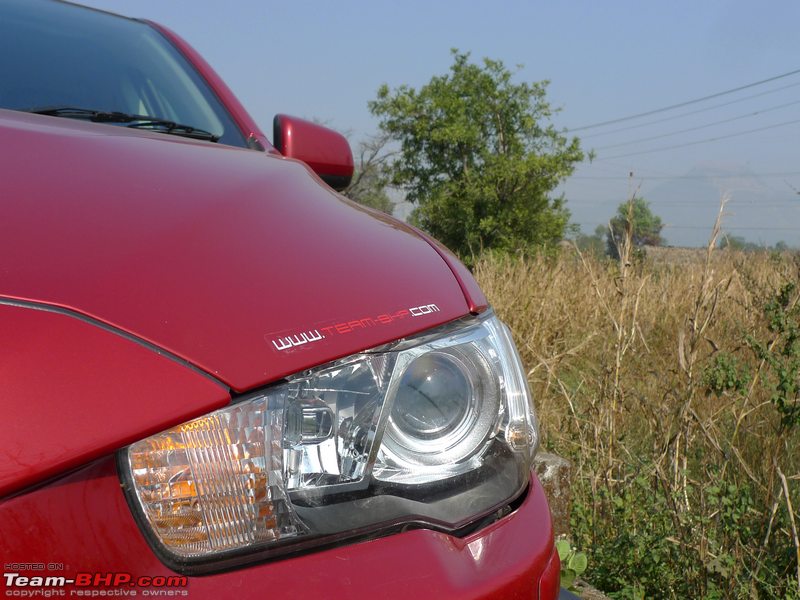 18 x 8.55" forged BBS alloys with 245/40 R18 (non-stock) Direzzas  The brake-cooling vent is the only plasticy looking part on the car 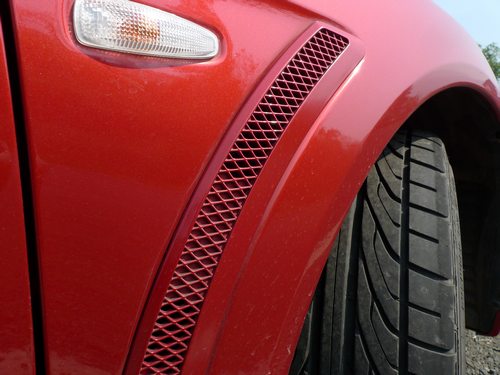 Long front overhang and 140 mm clearance didn't cause too many problems  When the key is in your pocket, touch the inside of either front door handles and the car unlocks. Press the small black button and all doors lock  Menacing long snout 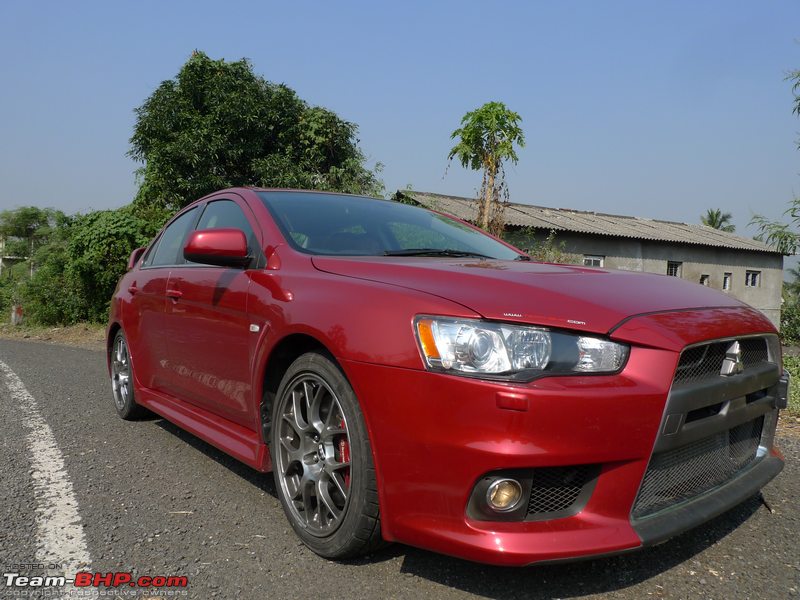 Notice the windshield rake and the slim & long front windows 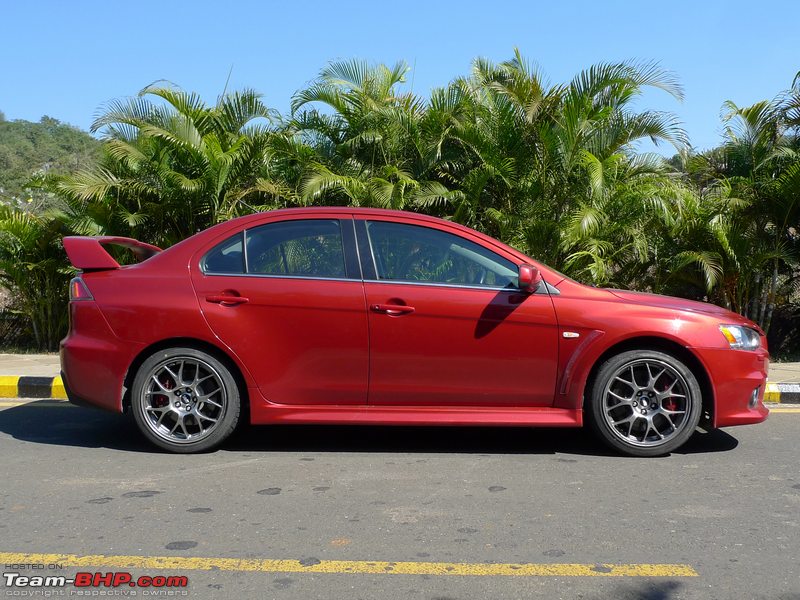 GTR-esque? (Also the LHS mirror is a tad smaller and angled differently, not sure why)  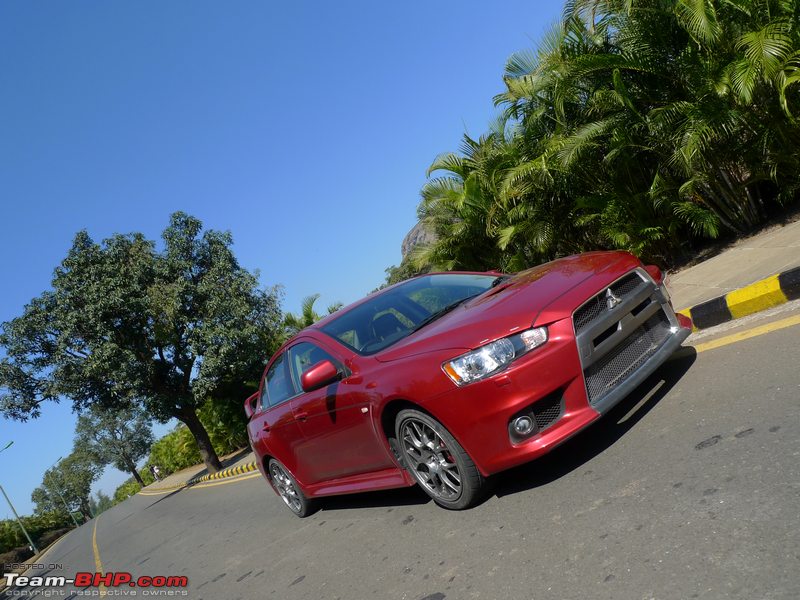 Wider and longer than the EVO IX 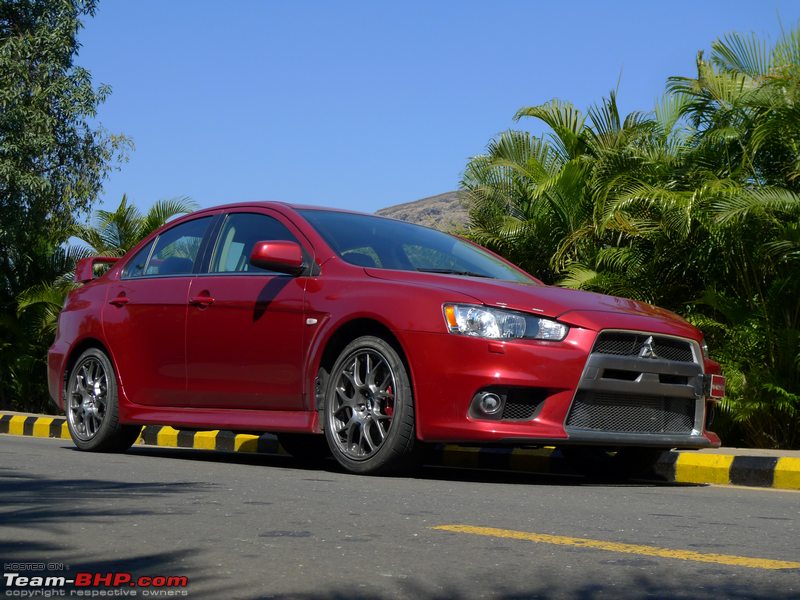 Flared hips, slender waistline and a bit of skirting 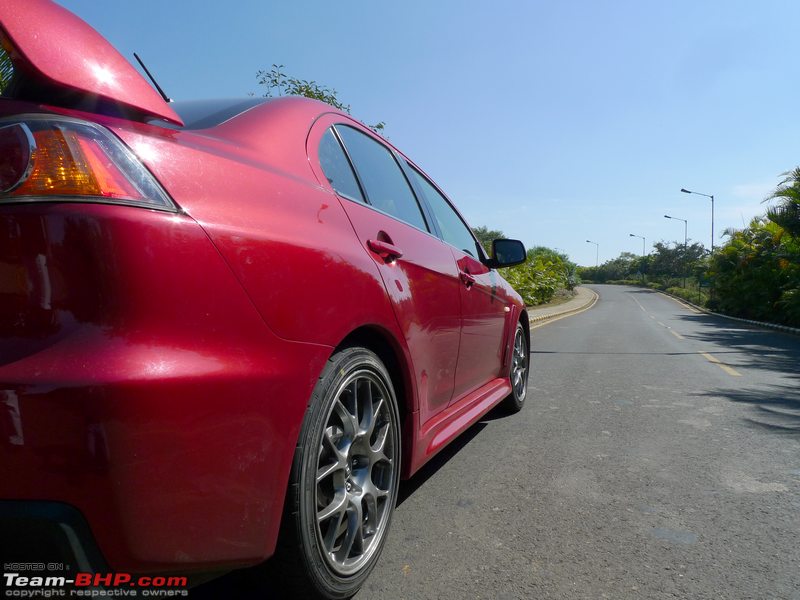 Twin pipes and a finned rear diffuser complement the big spoiler 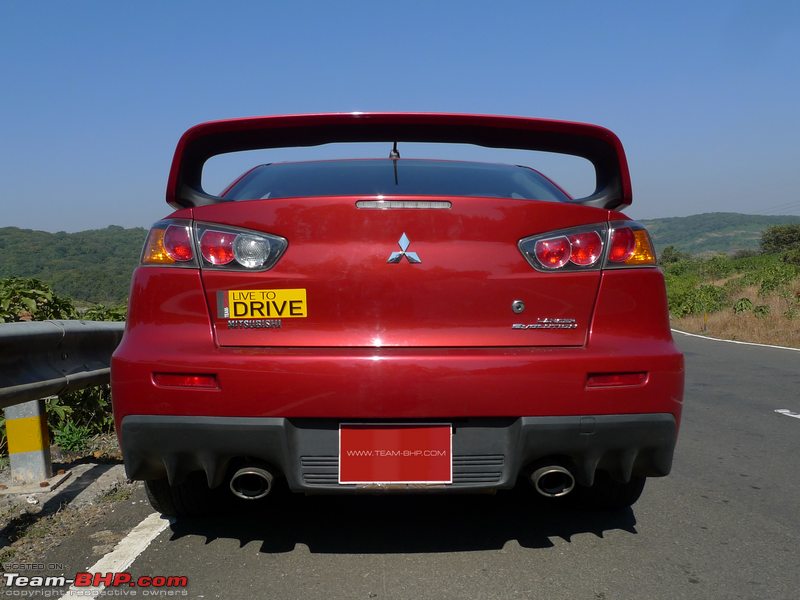 Aluminum roof and hood to reduce weight and lower the center of gravity  Rear tail lights stare at you in the same way as the "no fear" logo does  Begging you to come out and play 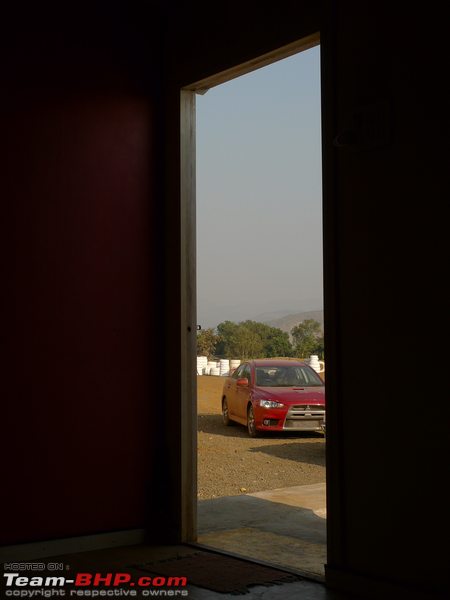 Functional venting on the hood to cool the radiator and turbo  At home in the dirt 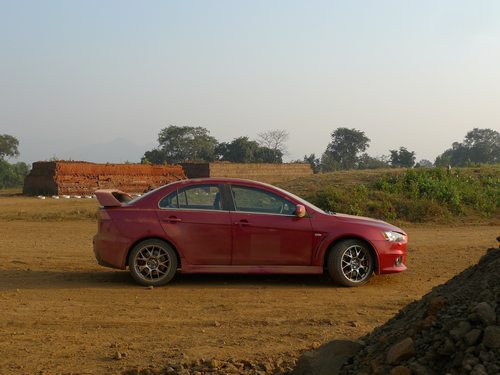 The front darth-vader grill is huge, but it serves the function of feeding the intercooler (visible below) tons of air 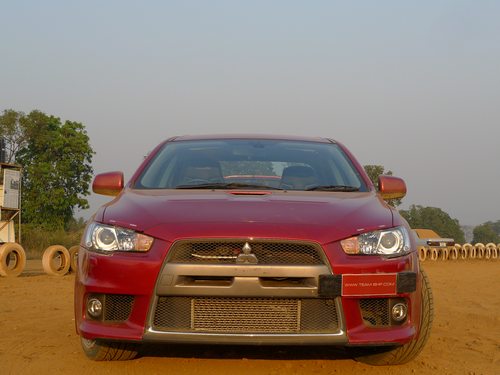 Notice the fold-over from the front grill swooping over the headlamps 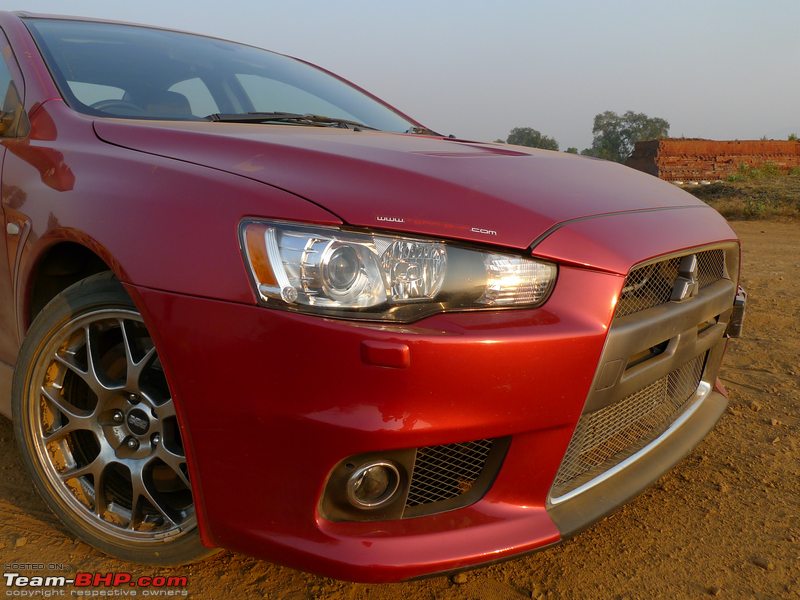 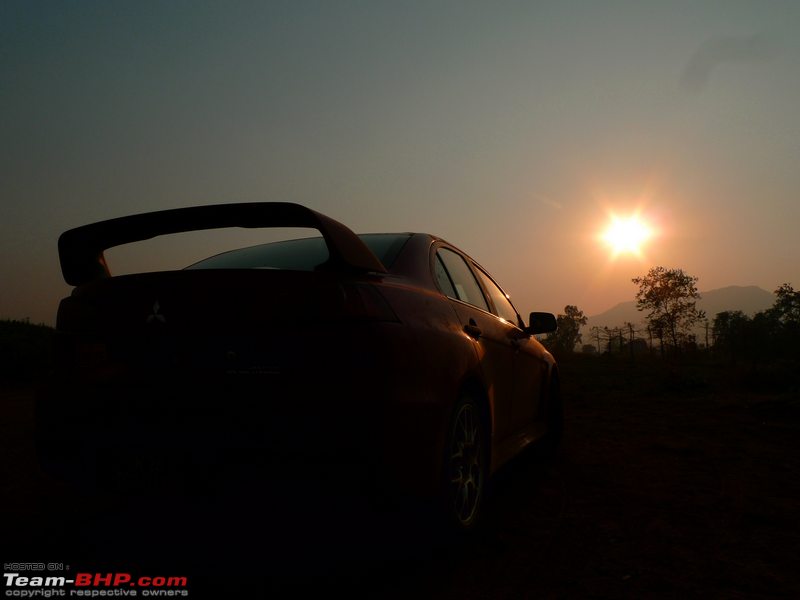 Last edited by Rehaan : 27th January 2011 at 10:32. |
| |  (8)
Thanks (8)
Thanks
 |
| The following 8 BHPians Thank Rehaan for this useful post: | Flyer, gaurav_chopra04, Researcher, sunny29584, swiftnfurious, SYSTEMIZED, Varun_HexaGuy, VTec_KickedInYo |
| | #3 |
| Team-BHP Support  Join Date: Feb 2004 Location: Bombay
Posts: 24,023
Thanked: 34,033 Times
| Interior  The first thing you notice when you sit in the car is that the seat is really low. Naturally you look for a seat-height adjuster, but it isn't present. In an STi you’d be looking out over a hood-scoop, in the EVO, you can barely see the bonnet. However, it only takes about 20 minutes of driving for you to get used to the low position. Black leather and “techno suede” Recaro seats hug you pretty tight. Not only do they have massive lateral support, but they also have wings on each side of the seat for shoulder and thigh support too. Much needed, with the EVOs cornering abilities. However, if you’re built a bit “healthy”, the seats might be an uncomfortable squeeze. All seat adjustments are mechanical, and finding a good (albeit low) driving position is fairly easy. Looking ahead you see a chunky steering wheel, with two long magnesium gearshift paddles peeking out at you over the steering spokes. No telescopic adjustment for the steering, only height adjustment. The instrument cluster has two straightforward and high-contrast dials for RPM and speed. In between them is a fairly impressive little colour MID display. You’ll find yourself referencing this screen a lot when switching between gearshift modes, road settings, being notified of traction control activation and of course, seeing how much further you can go before running out of gas. Despite the slim profile of the front windows, the forward visibility is great. There’s never the feeling of the A-pillars or anything else intruding into your field of view, and that’s quite essential for a car that’s made to corner. The outside RVMs are big and provide a nice field of view. The rear visibility however is blocked, not so much by the spoiler as the high parcel tray, boot-lid and three rear headrests. There's no reverse guidance system to help you out either. The foot-well is roomy (only two pedals, remember!) and there’s a huge dead pedal on the left. Useful for bracing yourself against when braking hard or cornering. The center console’s audio system, AC knobs (and even the gearshift paddles) are all identical to those of the Outlander. The EVO’s Rockford Fosgate 9-speaker audio system has excellent sound. It comes with a 650w 8-ch amp and a subwoofer in the boot. You can individually control the sub/bass/mid/treble settings, along with a few choices of the sound-stage (eg. concert hall, live, frontal stage, etc). We’d give it a 9/10 for SQ. The source can be the MP3 compatible 6-CD changer, or the aux-in line (which uses RCA inputs instead of the more pedestrian 3.5mm plug). However, it does not have USB input, Bluetooth or any kind of inbuilt storage. AC and climate control knobs are straightforward and easy to use. There are two individual compartments below `em. One for your iPod (since the RCA input is in the same cubby hole) and another one for your cell phone or the likes. You'll find tons of storage space inside this car. The covered dual cup-holders (beside the handbrake) are a convenient drop spot, and the large bin within the armrest lets you tuck even more stuff away. The front door pockets can store a litre bottle lying down, or 3 standing up. The gear-lever for the dual-clutch 6-speed SST transmission falls nicely into hand. I especially like that the last stop on the downward pull is “D”. This makes switching between “P” and “D” quick and easy to do without looking, unlike on cars where “D” has a few other “S” and “L” modes below it. As a safety lock, you need to lift the collar below the gear-knob when shifting between auto modes (ala Opel Astra reverse gear). A few people who drove the car found this inconvenient. When you’re in “D”, you can pull the lever sideways (towards you) to engage the Sport-tronic mode. This lets you shift manually. Push forward to downshift and pull back to up-shift. In this mode, the `box will never automatically up-shift for you. The transmission control switch near the base of the lever lets you switch between “Normal”, “Sport” and “Super-Sport” shift modes. The convenient position of this switch makes flipping into “Sport” mode super easy to do while driving, without taking your eyes off the road. You’ll find yourself using it often whenever you need a little extra punch. More on this later. The xenons can automatically turn themselves on when needed, and the same for the wipers. The wipers can also adjust wipe-interval according to the vehicle's speed, on top of the manual interval control of course. The AFS (Adaptive Front lighting System) a.k.a. cornering lights, turns on each fog-light individually when you point steering wheel in that direction. It doesn’t require a lot of steering rotation to activate this, and it’s a bit unnerving when you dial in a little opposite lock mid-corner and see the crashable scenery light up! Luckily the EVO has a fairly prominent button for turning off the active lights feature. Whew! Even when left on, they do not activate past 100km/h. On the safety side of things, there’s 7-airbags (2 Front, 2 side and 2 full-length curtain airbags, plus a driver’s knee airbag). Naturally ABS, EBD and ASC are all present, and will probably save your tail several times if you’re likely to push the car hard (there’s a detailed section on this below). All 4 windows have one-touch up and down, along with pinch protection, and a super-convenient keyless locking / unlocking and start system is provided too. All you have to do is keep the key in your pocket and your bare hands can do the rest. Its like magic. The rear bench is also fairly low to get into, but as soon as you make contact you feel a very soft and well padded seat. Very comfortable, however, it becomes clear that its just been made super-soft as a compensation for the stiffed up suspension. There’s Civic-like legroom in the rear, and even when I had 3 passengers on the back seat, they all mentioned how spacious the car was! This is one unique advantage the EVO brings. Not many cars in this performance bracket have room to take multiple friends along to share the fun. Luggage space on the other hand is a bit tight, with room for about 3-4 medium sized bags. To sum things up, Mitsubishi has provided : Xenons, Auto-on headlights & wipers, 9-speaker audio system with steering-mounted audio controls, 6-airbags, Super-All Wheel Control, climate control, forged 18" BBS alloy wheels, tilt adjustable steering, all 4 power windows with one touch up / down and pinch prevention, electric mirrors, cruise control and true keyless entry and start. Sorely missed is a height adjustable driver’s seat, parking sensors, reach adjustable steering and a USB input for the audio system. 3-spoke steering with the magnesium paddles peeping out  Clear and high-contrast instruments. The green bar is counter-intuitive though, the bigger it is, the more L/100 km  Fixed position paddles are long and easy to reach / operate 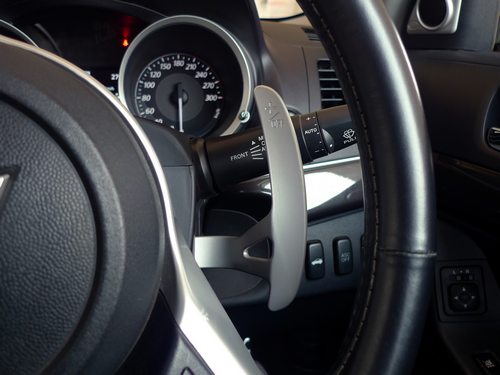 The interiors are fairly classy. There's nothing tacky or boy-racer about them  Rockford Fosgate 9-speaker audio system is nice 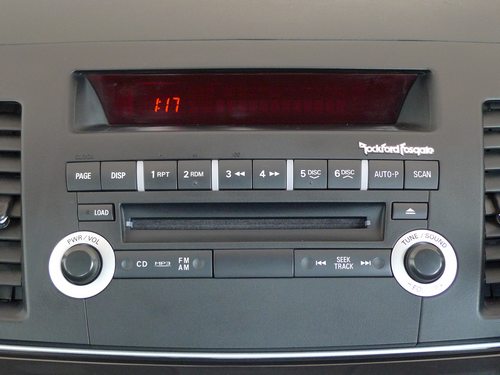 Straightforward and easy AC / climate control knobs  Space for ipod + RCA inputs for the aux-in line. In theory, a more solid and high quality connection 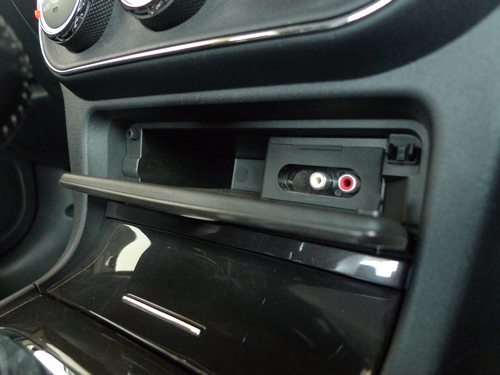 Another convenient little storage space  Leather wrapped gearknob for the SST 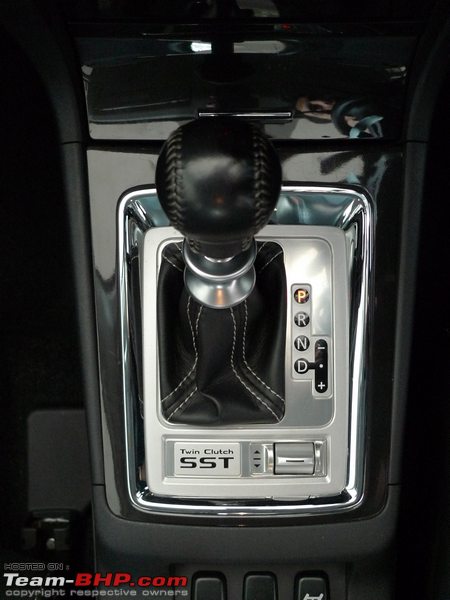 More storage and switches (Those are the seat heater buttons you see at the bottom)  Tons of foot-space and a massive dead-pedal  Auto-lighting. Push stalk to spray-wash the xenons  Large door pockets  Average sized glovebox 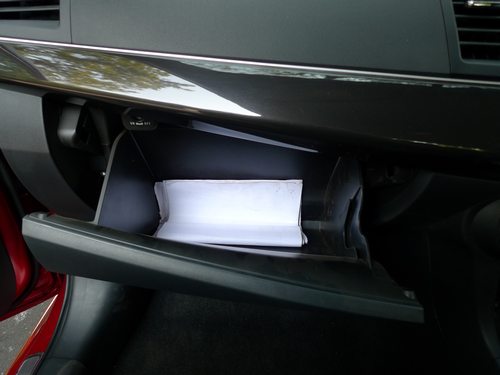 Body-hugging suede & leather Recaros  Large ORVMs give you a decent field of view  Rear visibility is blocked by the spoiler, high bootlid/parcel tray and 3 rear seat headrests  Rear bench is soft and comfy with tons of legroom  The trunk space suffers due to the complex AWD mechanicals below it 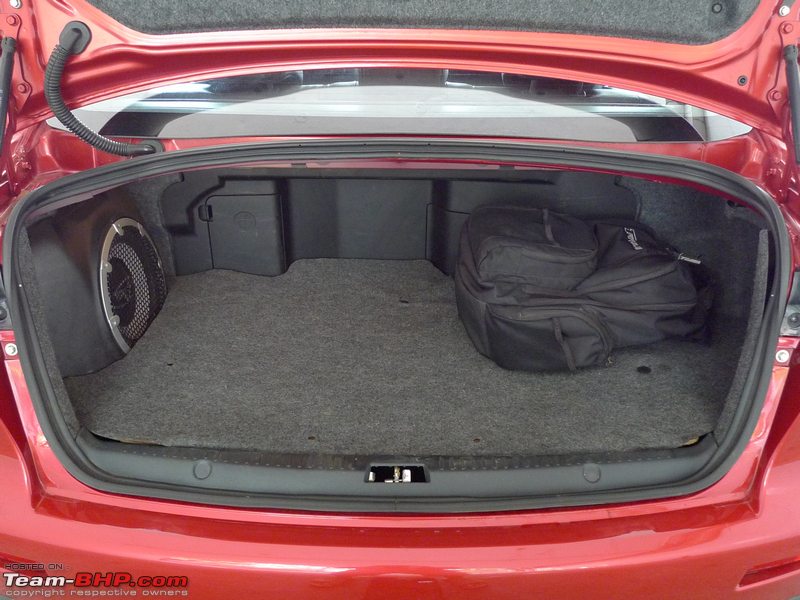 Last edited by Rehaan : 27th January 2011 at 16:45. |
| |  (8)
Thanks (8)
Thanks
 |
| The following 8 BHPians Thank Rehaan for this useful post: | Batfreak, Flyer, gaurav_chopra04, Nazaar25, Researcher, ShortShifter, Varun_HexaGuy, VTec_KickedInYo |
| | #4 |
| Team-BHP Support  Join Date: Feb 2004 Location: Bombay
Posts: 24,023
Thanked: 34,033 Times
| Super All Wheel Control S-AWC = ( ACD + AYC + ABS + ASC ) The electronic brain behind the EVO’s driving dynamics and cornering capabilities is the Super All Wheel Control (S-AWC). The term refers to the following four systems working together.  The S-AWC can be toggled by pressing the AWC button (also shown is the button for the adaptive front lighting system)  It has 3 pre-programmed settings that can be selected, depending on the driving conditions  Here’s what each of the individual systems do : ACD (Active Center Differential) Continuously decides what the breakup of power going to the front and rear should be. If the car is over-steering, it will put more power towards the front. AYC (Active Yaw Control) Controls the L/R torque split of just the rear wheels, therefore controlling yaw (i.e. the direction the car is pointing in). ABS (Anti-lock Braking System) This has been calibrated to be a less invasive “Sport ABS”. It also includes Electronic Brake-force Distribution (EBD) which helps keep the car’s composure when braking during a corner or on a loose road surface. The system has individual brake pressure sensors per caliper (rather than one per pair) which enables more accurate control and better linkup with the ASC. ASC (Active Stability Control) Manages engine control (limits overall power and torque when required) and also triggers braking and traction control. Center differential (ACD) is the central bar graph and rotational correction (AYC) is shown at the sides  Here’s how all the systems work together : 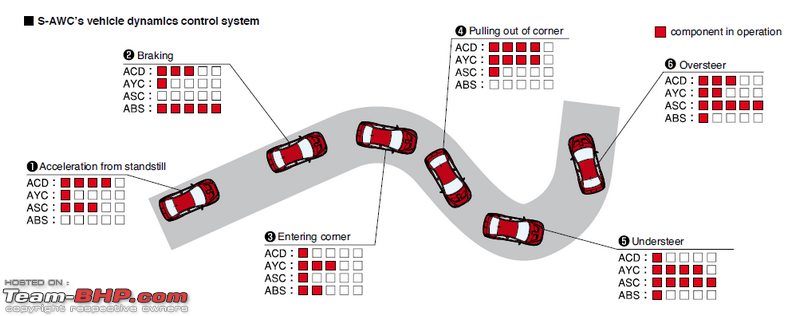  ASC is the only one of these 4 systems that can be individually restricted via a button, similar to how you can turn off traction control in some cars.  The ASC has 3 settings :
|
| |  (7)
Thanks (7)
Thanks
 |
| The following 7 BHPians Thank Rehaan for this useful post: | Flyer, gaurav_chopra04, Nazaar25, Omkar, Researcher, Varun_HexaGuy, Vasuki |
| | #5 |
| Team-BHP Support  Join Date: Feb 2004 Location: Bombay
Posts: 24,023
Thanked: 34,033 Times
| Engine  ENGINE The 4B11 Turbo is a completely different beast from the naturally aspirated 4B11 found in the current gen Lancer. Its had over 90% of its parts upgraded or re-designed to handle more power and provide better internal cooling. - 2L (1998cc) Turbocharged DOHC w/ intercooler - 16 valve + multi-point fuel injection - 9.0:1 compression ratio (but remember its forced induction, so high-octane is recommended) - 292 Bhp @ 6500 rpm - 366 N-m @ 3500 rpm - MIVEC Variable valve timing (for intake as well as exhaust valves) - Aluminum compressor wheel and titanium turbine wheel for the turbo which Mitsubishi says is 18% more efficient than the last gen - Sodium filled exhaust valves (SFEVs) help cool the valves by transferring heat from the valve faces up the stems - 12 kgs lighter and placed 10mm lower than EVO IX’s engine Note: We get the FQ-300 (not the FQ-330 or FQ-360 as available in UK markets). Yes, the numbers roughly correspond to the power output. Add to that, we seem to be getting the Euro / Australian-spec version of the FQ-300, with 366 N-m of torque instead of the 407 N-m version that the UK and America get.  GEARBOX The gearbox is a 6-speed dual-clutch automated-manual transmission that Mitsubishi calls the “Twin-Clutch Super Sport Transmission” (TC-SST for short). Let break that up. Twin-clutch, means that there is one clutch for all odd numbered gears (1, 3, 5) and another one for all even gears (2, 4, 6). So when you’re in 3rd gear, the corresponding clutch is engaged, but as you shift up, 4th gear is selected and the second clutch starts to engage at exactly the same time the first clutch is disengaged. This happens simultaneously, meaning there’s virtually no drop in power during the shift, and its super fast and smooth. The SST has different modes which alter how aggressively the transmission shifts, what RPM it shifts at, and whether or not it automatically up-shifts at redline when the driver is in manual mode. The modes are titled “Normal”, “Sport” and “Super-Sport”. By default, the gearbox will shift automatically for you in all of these modes. To engage manual shifting, you can either pull the gear-lever over to the Sport-tronic position, or pull one of the steering wheel paddles. To switch back to automatic, move the gear lever back to “D”, or keep the right paddle pulled for 2 seconds. Normal mode is great for everyday driving, with smooth and jerk-free shifts and a keenness to up-shift when you’re not too heavy on the gas. Its like a normal automatic and you can’t expect sporty performance in this mode. When trying to drive quick in this mode, you will feel the turbo and transmission lag, since the gearbox doesn’t keep the RPMs too high and doesn’t downshift very aggressively. When you push the switch forward to get into “Sport” mode, the MID pops up the change and the difference is noticeable instantly. Usually the change is accompanied by a downshift, making the car seem much sharper and more responsive right away. This is when the EVO starts to come alive. The gearbox stays up longer, gives you more engine braking and downshifts aggressively too – not letting the engine drop below 3,000rpm in most cases. It will hold the gear when you’re heavy on the gas, but once you let off, it will eventually up-shift. For everyday driving, sport mode is too busy/jumpy and can get a bit overwhelming, so don’t expect to use it all the time. Pro-Tip : If you get an opportunity to have a short stint in an EVO, remember to put it in Sport mode! For something special, keep the transmission mode switch pushed forward for 3 seconds. You need to be at a standstill to do this. S-Sport will be displayed on the MID and you’re in Super-Sport mode! This keeps the car above 4,500 rpm whenever possible and makes the shifting lightning quick. From the point of view of a guy who loves the pure manual, I have to say that I have virtually no complaints about this gearbox! Its extremely user friendly, and as long as you’re in the right mode it doesn’t ever keep you waiting or wanting more. Also, as Mpower rightly mentioned, the fact that you don’t also have to shift gears manually lets you concentrate 100% on your steering input and fine-tune your lines. POWER First things first, lets get this out of the way: this isn’t the car that’s gonna scare the living daylights out of you in a straight line. This isn’t the car that’s got head-crushing acceleration. At least not this FQ-300 version. However, what it is going to do is scare the living daylights out of your passengers once the road gets twisty, while making you look like Loeb. At idle, or even when cruising with your foot touching the gas, a deep bassy hum is evident. Its not very overbearing, and chances are it won't bother the passengers – but it lets people know that there’s something lurking there beneath the hood. If you’re expecting a loud turbo whistle and blow off valve whoosh, you’re gonna be a bit disappointed since the turbo is vented internally (should be easy to change though). Step on the gas, and the power is surprisingly linear. Past 4,000 rpm the engine starts to take on a different note and the turbo whistle becomes noticeable. It will pull all the way past its 7,000 rpm marked redline till about 7,400 before it bounces off the rev limiter. Surprisingly, there’s very little turbo-lag, and even less of a noticeable turbo kick. Its shockingly domesticated and refined. When you’re in full-manual mode, that’s when you’re much more likely to notice what’s present of the turbo lag. This is because there isn’t an intelligent transmission paying full attention to keeping your RPM high to keep the turbo spooled up. Even though the sticker on the fuel flap says “98 ONLY”, the car ran fine on regular petrol. Though we did try both 97, regular and a mix, surprisingly we couldn’t notice a difference in day to day driving. STEERING FEEL Another surprise is that the steering on the EVO is fairly light. Though not quite as light as an EPS-hatchback, its definitely not as tight or heavy as a Fiesta or Civic. Add to that, there is zero feedback. There’s really no telling what the front wheels are upto. There’s very little tyre squeal and the steering doesn’t communicate anything back to the driver. Its like a videogame. Point and shoot. Mpower stacked this up against his e36 M3 in comparison, which is razor sharp and lets you know what you’re doing. Personally, I enjoy the chuckability of a light steering, but could have really used some communication from the front tyres for a more involving and rewarding driving experience. HANDLING + ELECTRONIC AIDS This is where the EVO is crazy. It gives you so much more room for error than you normally would have, and quietly forgives and corrects most mistakes for you. The car holds the road really well, and when you turn it in a little harder than normal, you feel the “hand of god” so to speak, keeping you on your track. I was hitting the brakes 2/3rds as hard (or should I say soft), and hitting the gas 3-5 seconds before I normally would, when exiting a tight corner. 9 times out of 10 the EVO got me through it without a fuss! This car just helps you out of almost any situation you can manage to get into. Unlike in a Merc or other cars where the ESP light only flashes when the system is doing its work, on the EVO a warning stays on the MID for a few seconds after the system has chimed in, just to let you know that there was some divine intervention. Useful with this car, as chances are you’ve got your hands too full to notice when the regular ESP light was flashing anyway. Its hard to define this car as a “neutral handler” or “likely to understeer” etc. Lets make up a new term called “computer-steer”. If the EVO thinks you need understeer, it dials that in – and if it thinks you need oversteer it serves that up in small quantities too. It does a pretty good job of deciding what you need in order to keep the car going where you’re pointed. For an AWD with massive traction, its surprisingly easy to get the tail out a little on corners - point into a tight turn and give it some gas, and the electronics will let you get the tail out just a slight amount before reeling you back in safely. Of course, you can progressively switch off the ASC, in order to have a little less of the interference and synthetic-ness of the computer-steer, but that comes with its own risks too. The S-AWC systems and massive AWD grip do an amazing job of masking speed on the corners. You’re cornering in multiples of any speed that you normally would, and you don’t even realize. However, despite the great road holding, the combination of the firm suspension, low-profile tyres and Indian roads mean that when you hit a slight bump or road imperfection you’ll be jumping sideways and going a little off track. If you want to feel directly connected to every element of the car, the steering, the traction, the transmission – this is probably not the car for you. Its not a car that challenges you as a driver, its not a car for purists - there’s too much going on behind the scenes. SUSPENSION & RIDE The ride is not bone-crushing firm, like some other EVOs, but it clearly feels like the suspension hasn’t got a very long travel. The Bilstein shock absorbers and Eibach coil springs handle small and medium size bumps better than you’d expect, however when you get the large bumps and potholes, that’s when there will be thuds and complaints from the rear (yes, that’s a pun). On faster roads that have a lot of smooth ups and downs you’ll find that the car has a fair deal of vertical movement (especially noticeable for the rear seat passengers), though it isn’t the constant bouncy movement that induces today’s lunch. Its more of a road-hugging behaviour. In the cabin, wind and tyre noise are quite prominent, even at relatively low speeds like 80 km/h. BRAKES Brembo's 350 mm 2-piece aluminum center discs clamped by quad-piston front calipers and dual-piston one-piece calipers at the rear promise a very good feel, with more linearity and better fade properties, pointed out Mpower. But that’s only theory. Unfortunately, the car that we test drove had about 1mm of material left on the brake pads when we got it. This meant that we couldn’t experience the brakes to their full potential and therefore can’t comment much on their performance. With the hardware they come with, there’s little doubt that they’re anything less than impressive. However, as a result, we did a fair deal of engine-braking, and I can safely add that the automatic blip of the engine on the downshift sounds sweet! FUEL EFFICIENCY This 2L I-4 is thirstier than most V6s! Several reviews and ownership reports say that even when driven with a light foot in “Normal” mode, she has a drinking problem. Of all the cars we’ve tested, we’ve never re-fueled one so often! From brim to brim, 230 km of driving (20% city cruising + 20% dirt track + 30% spirited twisties + 30% high speed highway), that too 40% in “Sport” and 60% in “Normal” drank a good 43.5 Liters. That’s about 5.3 km/L. At this rate, the 55 L fuel tank would take you about 292 km till the last drop. IN CITY In-city drivability is great. There are no major concerns at all. The steering is manageable, there’s no sudden surges of power, 140 mm of GC is respectable and the SST transmission takes care of everything – its really like driving an everyday sedan in this aspect. On the flip-side, the turning circle is absolute rubbish. 5.9 meters! Expect 3-point turns everywhere. Mpower chimes in again: Since the car is based on the regular Lancer (designed for thinner rubber), the 245mm tyres and wider wheels of the EVO naturally reduce the amount you can safely turn the wheels, resulting in a poor turning circle. Another minor point to note is that because you’re sitting so low, you don’t have a very commanding view of low-lying objects. For example, when taking a turn onto a divided road, you lose sight of the median much before it gets close to the car. If you’re considering the EVO as a daily driver for Indian roads, there’s really nothing much to worry about. The power is linear and manageable, the shifts are smooth, the ground clearance isn’t an issue. The only sore points are listed above. Then again, this is probably more applicable to international markets where it will be the only car / daily driver for a lot of the buyers. In India, at this price point that’s much less likely.  ON THE DIRT The S-AWC has three settings: Tarmac, Gravel and Snow. We thought we should at least test 2 of them out, so we headed to the AutoMission track at Khopoli. Never having driven something this powerful on dirt before, I approached the first lap with caution. One lap later, I was hitting it hard. Dabs of opposite lock, controlled drifts, plumes of dust and very little hesitation. This is where the S-AWC comes in. In the gravel setting, it let us play in the dirt, but nothing got out of control. Not a single fishtail or spin out. Dippy had a go as well, opposite-lock, tail-slide, no problem. This thing makes it so easy! Mpower’s earlier reservations about the less-direct steering and the (relatively) soft suspension compared to his M3 started to make sense now. The EVO flew over rutts, mounds and ridges of dirt with ease and absolute composure. Not many other road-going cars can play both sides of this duality so well.        The two front vents are the exhausters for the radiator, and the single scoop is for cooling the turbo and exhaust manifold  The exhausters as viewed from inside. Air comes in the front grill, flows over the intercooler & radiator, and gets pulled out of here  The inside of the single scoop...  ...shoots air down onto this  A solid strut bar comes as standard fitment. Its even secured onto the chassis at a third point mid-bar 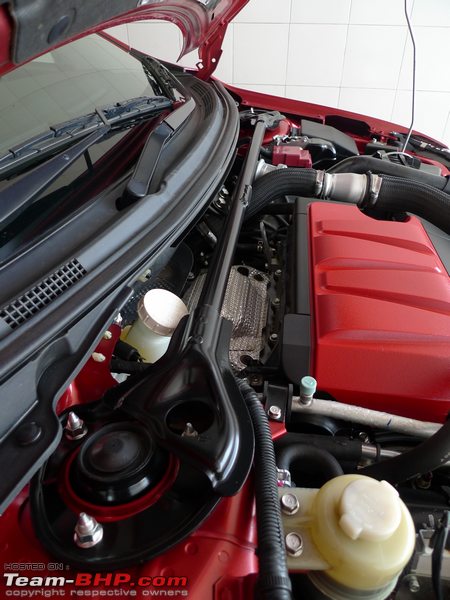 The windshield washer fluid container (for reference later)  The straight-shot air intake design is possible since the battery is in the boot  Sport mode engaged!  A peep at the mechanicals from under the car  Last edited by Rehaan : 27th January 2011 at 11:03. |
| |  (6)
Thanks (6)
Thanks
 |
| The following 6 BHPians Thank Rehaan for this useful post: | Flyer, gaurav_chopra04, Leoshashi, Researcher, Varun_HexaGuy, VTec_KickedInYo |
| | #6 |
| Team-BHP Support  Join Date: Feb 2004 Location: Bombay
Posts: 24,023
Thanked: 34,033 Times
| Other points Other Points: • You can start the car without having to put your foot on the brake pedal. Of course the transmission has to be in “P”. • No intercooler spray. That’s the STi’s domain. • Stepping out of the low seat directly onto a raised footpath is quite a challenge. • After driving the EVO, you get into a car like the Civic, which has a fairly low seating position and you feel like you’re sitting on the high-perched driver’s seat of a bus! • The hardcore drivers will be disappointed that the car always starts up in “Normal” mode, even if you shut it off when on “Sport” mode. • A “Slow down” warning will appear if you overheat the SST transmission or the Brembos. Nope, luckily we didn’t experience this. • Even though the battery is in the boot, there’s a point in the engine bay where you can connect to the positive terminal in case you ever need jump-start the car. • The after-run fan function keeps the radiator and condenser fans on for an additional 3 minutes after you turn the car off. It’s pretty loud. • In some ways, seeing an EVO X on Indian roads is more exotic and exciting than a Porsche or AMG. Also you know that only a true enthusiast is going to cough up the dough for one of these. • Get an additional 36bhp and 22lb/ft with the 330 aftermarket power upgrade : Link • When a money grubbing seller or service person asks you “for which car?” before telling you the price, you can always say “Lancer”  • Irritating beeping noise on the inside of the car when you put it in reverse! Its not a reverse sensor. Just a warning beep that is apparently present on all JDM automatic cars. Also, every kind of warning is the same sounding “beep”, regardless of if you left the headlights on or haven’t worn your seatbelt. • There are rumours that the next gen EVO XI will be a diesel hybrid, due to ever tightening emissions regulations! • It’s a pity Mitsu doesn’t have this generation lancer on sale in India, because that would have linked up nicely, but atleast they do have the outlander which has a face that can immediately be tied to the EVO. • If you don’t turn the plastic ignition knob to the lock position before exiting the car, it beeps several times when you try and lock the door. In our typically noisy surroundings its quite likely you won’t hear that, and the car will remain unlocked! • Even though this test-car has gone through a very rough last 7,000+ kms on-track and off it in the hands of many journalists, there still wasn’t a single squeak or rattle from anywhere in the car. • The gas-struts actually make the boot-lid really heavy to lift, instead of making it easier. • “The Evolution Theory” is a booklet about the EVO thats worth taking a look at : Link. Its also the source of a few of the S-AWC diagrams used above. • A big thanks to Mpower and Dippy for additional points, photos and video! Last edited by Rehaan : 27th January 2011 at 10:59. |
| |  (4)
Thanks (4)
Thanks
 |
| The following 4 BHPians Thank Rehaan for this useful post: | Flyer, gaurav_chopra04, petrolhead_neel, Researcher |
| | #7 |
| Team-BHP Support  Join Date: Feb 2004 Location: Bombay
Posts: 24,023
Thanked: 34,033 Times
| Smaller yet significant The smaller yet significant things The xenons are actually a single projector with an electrically controlled shutter to switch from high to low  Forged wheels. Lighter, stronger, more expensive  Enkei cast alloy for the full-sized spare tyre (it’s the standard alloy design on the lower-variant EVOs worldwide)   Massive head-rests with faux 5-point harness holes  Seats protrude out a little to give you support all the way till under your knee  Manual knob for the seat-back adjustment  Height adjustable seatbelts are a necessity. With the hard cornering a misaligned seatbelt will slip off your shoulder.  The collar has to be lifted when shifting to "P", "R" or "D" 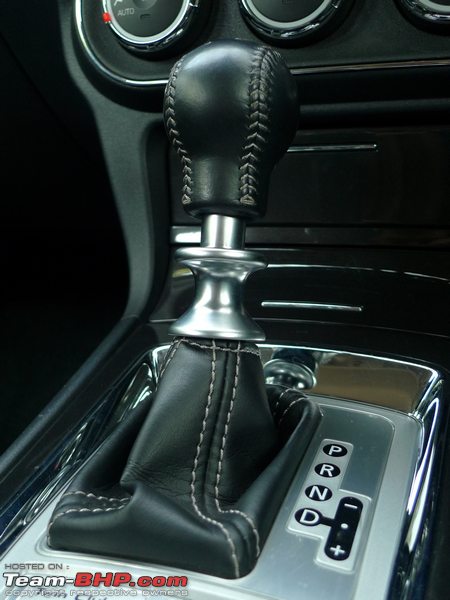 The rear arm-rest flops down. Not the best arm support  Piano black finish on the interiors has a classy feel  All windows have one-touch up and down, along with pinch protection 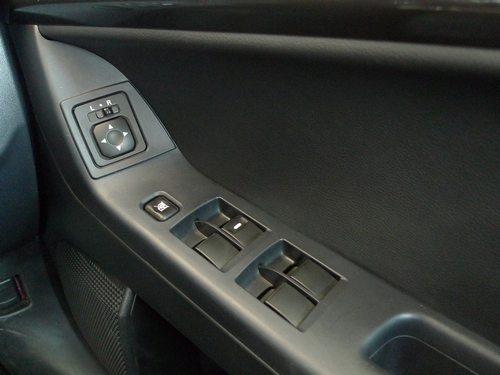 Toggle through the MID displays (tripmeters, distance to empty, S-AWC display)  The knob that replaces the key. Wish there was a "START" button instead  AC vents can be closed  The epic badging, and the less epic button to open the boot  10" Sub-woofer in the trunk  To balance out weight, and make room for the air-box, the battery has been moved back here The other container has a windshield wiper icon on it, though the washer fluid container is up front too. Usually this is the reservoir for the hydraulic fluid which controls the AYC and ACD differentials, but that doesn't seem to be the case here. Not sure why  Yikes. Will have to make do with 97, or less...  Jet-fighter inspired front air scoop  When was the last time you saw a 50+ lakh car with one of these to hold the hood up?  Only the people in the know stop and stare...or take pictures  Wireless remote and key substitute. Put it in your pocket and forget about it. Just like the Outlander 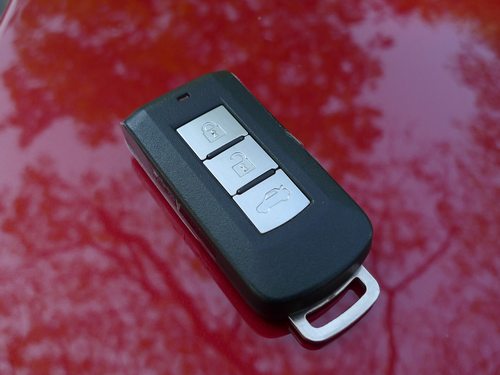 Last edited by Rehaan : 27th January 2011 at 11:02. |
| |  (11)
Thanks (11)
Thanks
 |
| The following 11 BHPians Thank Rehaan for this useful post: | ashishk29, Batfreak, Crazy_cars_guy, fast&furious, Flyer, gaurav_chopra04, petrolhead_neel, Researcher, ShortShifter, Varun_HexaGuy, VTec_KickedInYo |
| | #8 |
| BHPian | Re: Mitsubishi Lancer EVO X : Test Drive & Review Wow! The review I have been waiting for. Now need to see how many of these will rule the Indian roads. Nice job guys! Thanks for the detailed review. |
| |  ()
Thanks ()
Thanks
 |
| | #9 |
| BHPian Join Date: Nov 2007 Location: Goa / Leicester
Posts: 762
Thanked: 419 Times
| Re: Mitsubishi Lancer EVO X : Test Drive & Review Detail review Rehaan as usual, beautiful car but way overpriced. Last edited by GTO : 13th January 2011 at 16:51. Reason: It's Rehaan who has compiled the review :) |
| |  ()
Thanks ()
Thanks
 |
| | #11 |
| Senior - BHPian | Re: Mitsubishi Lancer EVO X : Test Drive & Review Mind blowing review. Felt like lived it through,word by word, picture by picture. Agree with you, only those who know it would appreciate it. Isn't it the same for most of the geniuses? And as usual, give me the honor of first to comment on the EVO's test drive. EDIT: (Oooops. There are two already by the time I clicked. That's ok, this is Team-bhp, not any haire phaire car portal. Hai na?) Query: You mentioned left side ORVM is smaller than right side and a bit angled more. Did you eventually find out why? And: We Want Wedio Last edited by RajaTaurus : 13th January 2011 at 15:23. |
| |  ()
Thanks ()
Thanks
 |
| |
| | #12 |
| BHPian | Re: Mitsubishi Lancer EVO X : Test Drive & Review What a review Rehaan, Awesome. Thanks for taking the time for review. |
| |  ()
Thanks ()
Thanks
 |
| | #13 |
| Team-BHP Support  Join Date: Dec 2006 Location: Mumbai
Posts: 10,265
Thanked: 12,316 Times
| Re: Mitsubishi Lancer EVO X : Test Drive & Review Brilliant, just brilliant. What a review  And the Evo seems to be a great car, to use everyday. If only they had priced it cheaper. Or for this price we should have got the FQ-360. |
| |  ()
Thanks ()
Thanks
 |
| | #14 |
| BHPian Join Date: Jun 2010 Location: Bangalore
Posts: 209
Thanked: 222 Times
| Re: Mitsubishi Lancer EVO X : Test Drive & Review Wow! What a car and an equally impressive and exhaustive review. I wish I could afford. Is it me or do the seats look like Darth Vader profile? |
| |  ()
Thanks ()
Thanks
 |
 |


